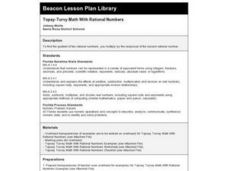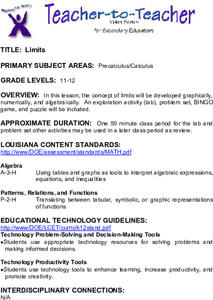Curated OER
Algebra I: A Draining Swimming Pool
Learners analyze and develop symbolic representations to describe the amount of water left in a pool being pumped out after a given amount of time, with various pumping rates and initial quantities of water in the pool.
Curated OER
Topsy-Turvy Math With Rational Numbers
Fourth graders complete a worksheet. As a whole class, 4th graders hear a lecture and complete a worksheet on factors, multiplicative inverses and reciprocals, finding the quotient of two fractions and the division of fractions to...
Curated OER
Mixed Expressions and Complex Fractions
Students are introduced to mixed expressions and complex fractions. They work through several problems with the instructor and then complete a worksheet.
Curated OER
Limits
Students practice the concept of limits graphically, numerically and algebraically. They participate in an exploration lab, BINGO game and complete a puzzle.
Curated OER
Patterns in Pascal's Triangle
Students examine the patterns that exist in Pascal's Triangle. They explore multiples and factors. Sudents use an applet to create and color the multiples in Pascal's Triangle.
Curated OER
Area graphics for 7th graders
Pupils randomly select dimensions for three geometric shapes (square, right triangle and circle). From the graphs they compare and contrast the graphical results of each shape.
Other
Nearpod: Quadratic Equations: Intro & Factoring
In this lesson, students will learn the main parts of a parabola and solve quadratic equations by factoring.
Alabama Learning Exchange
Alex: "Factoring by Mack"
This strategy for factoring trinomials will eliminate the trial-and-error method used in most textbooks.The lesson plan will be a direct teaching lesson plan. With the teacher lecturing and the students taking notes and then having the...
Alabama Learning Exchange
Alex: Zero Product Property
The zero product property allows you to solve a quadratic equation by converting it into two linear equations. This is a common strategy of algebra--to break down a problem into simpler parts, each solved by previously learned methods.








